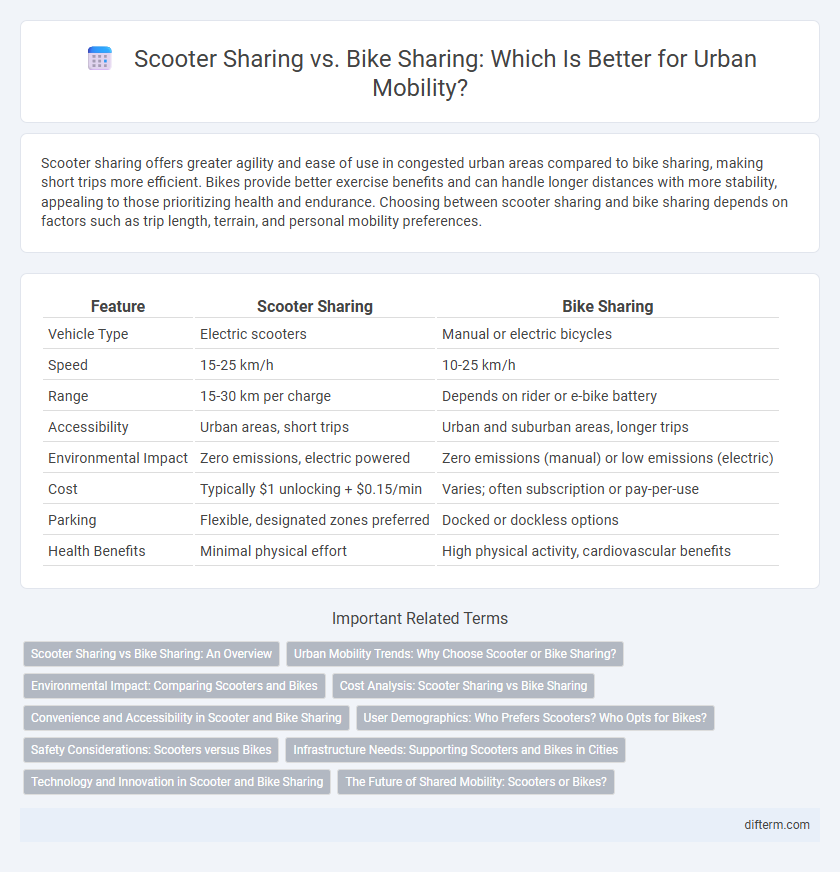Scooter sharing offers greater agility and ease of use in congested urban areas compared to bike sharing, making short trips more efficient. Bikes provide better exercise benefits and can handle longer distances with more stability, appealing to those prioritizing health and endurance. Choosing between scooter sharing and bike sharing depends on factors such as trip length, terrain, and personal mobility preferences.
Table of Comparison
| Feature | Scooter Sharing | Bike Sharing |
|---|---|---|
| Vehicle Type | Electric scooters | Manual or electric bicycles |
| Speed | 15-25 km/h | 10-25 km/h |
| Range | 15-30 km per charge | Depends on rider or e-bike battery |
| Accessibility | Urban areas, short trips | Urban and suburban areas, longer trips |
| Environmental Impact | Zero emissions, electric powered | Zero emissions (manual) or low emissions (electric) |
| Cost | Typically $1 unlocking + $0.15/min | Varies; often subscription or pay-per-use |
| Parking | Flexible, designated zones preferred | Docked or dockless options |
| Health Benefits | Minimal physical effort | High physical activity, cardiovascular benefits |
Scooter Sharing vs Bike Sharing: An Overview
Scooter sharing provides flexible, motorized transport suited for short urban trips with speeds typically ranging from 15 to 25 km/h, while bike sharing offers pedal-powered options promoting physical activity and eco-friendly commuting. Scooter sharing systems often feature GPS tracking and mobile app integration for easy rentals, whereas bike sharing networks emphasize docking stations and infrastructure for safe cycling paths. Both services reduce reliance on personal vehicles, lower emissions, and enhance last-mile connectivity in densely populated cities.
Urban Mobility Trends: Why Choose Scooter or Bike Sharing?
Scooter sharing offers greater speed and reduced effort for short to medium urban trips, addressing last-mile connectivity in dense city areas more efficiently than bike sharing. Bike sharing promotes health benefits and sustainability by encouraging physical activity and reducing carbon emissions, making it ideal for longer or leisure rides across urban greenways. Both options cater to diverse mobility needs, but scooter sharing excels in convenience and accessibility, while bike sharing supports environmental goals and active lifestyles.
Environmental Impact: Comparing Scooters and Bikes
Scooter sharing and bike sharing both contribute to reducing carbon emissions by replacing car trips with zero-emission transportation options. Bikes have a lower environmental impact due to their simpler design, longer lifespan, and lack of batteries that require frequent charging and disposal. Conversely, electric scooters rely on batteries that generate electronic waste and require energy for charging, somewhat diminishing their overall environmental benefits compared to traditional bikes.
Cost Analysis: Scooter Sharing vs Bike Sharing
Scooter sharing generally incurs higher operational and maintenance costs due to battery replacement and more frequent repairs compared to bike sharing. While bike sharing systems benefit from lower infrastructure expenses and longer equipment lifespan, their lower speed and range can impact user convenience and overall service efficiency. Evaluating total cost of ownership highlights that bike sharing offers more cost-effective urban mobility solutions, especially for short-distance commuting.
Convenience and Accessibility in Scooter and Bike Sharing
Scooter sharing offers enhanced convenience with faster rentals and easier parking in urban environments compared to bike sharing, which often requires docking stations. Bikes provide greater accessibility for longer distances and diverse terrains, while scooters excel in short trips and quick urban mobility. Integration of real-time app tracking in both systems improves user access, but scooters generally offer more flexible, on-demand usage.
User Demographics: Who Prefers Scooters? Who Opts for Bikes?
Scooter sharing attracts predominantly young urban professionals aged 18-34 who prioritize speed and convenience for short commutes, especially in densely populated city centers. Bike sharing appeals to a broader age range, including families and fitness enthusiasts, often favoring environmentally conscious users seeking moderate exercise and longer ride durations. Studies indicate that women are more inclined towards bike sharing due to perceived safety and comfort, while men tend to prefer scooters for quicker, more agile transportation.
Safety Considerations: Scooters versus Bikes
Scooter sharing presents unique safety challenges compared to bike sharing due to higher speeds and less stability, increasing the risk of falls and collisions. Bikes generally offer better balance and are equipped with more visible lighting and durable braking systems, enhancing rider safety. Helmets are critical for both, but scooter users often exhibit lower compliance, making safety campaigns and infrastructure improvements essential.
Infrastructure Needs: Supporting Scooters and Bikes in Cities
Scooter sharing requires robust charging stations and designated parking zones to prevent urban clutter, while bike sharing demands extensive network of bike lanes and durable docking stations to ensure user safety and accessibility. Cities must invest in smart infrastructure, integrating IoT-connected racks for real-time availability tracking in both systems. Effective urban planning prioritizes seamless connectivity between scooter and bike lanes to promote multimodal mobility and reduce traffic congestion.
Technology and Innovation in Scooter and Bike Sharing
Scooter sharing leverages advanced GPS tracking, IoT sensors, and mobile app integration to enhance real-time fleet management and user experience. Bike sharing systems increasingly incorporate smart locks, electric-assist technology, and AI algorithms for demand prediction and route optimization. Innovations in both sectors focus on seamless connectivity, sustainable energy use, and data-driven operational efficiency to transform urban mobility.
The Future of Shared Mobility: Scooters or Bikes?
Scooter sharing and bike sharing represent key pillars in the evolution of shared mobility, each offering unique benefits tailored to urban environments. Electric scooters provide rapid, last-mile connectivity and appeal to users seeking convenience and speed, while bike sharing supports longer trips and promotes health and sustainability. The future of shared mobility will likely integrate both modes through smart, interoperable platforms that optimize routes, reduce congestion, and enhance urban accessibility.
scooter sharing vs bike sharing Infographic

 difterm.com
difterm.com